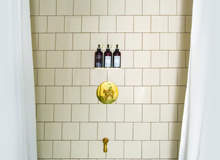
“See and be seen” might be an integral concept to many hotels but, when it comes to the bathrooms, the jury is out. There is such a prolific trend in peek-a-boo, open-plan bathrooms that the New York Times devoted a story to it earlier this year, while online forums buzz with the voices of the dissenting modest and bashful.
There’s no denying that removing the walls between a bedroom and bathroom can seem to enlarge what may be an otherwise small space, but for many guests it can be intimidating.
At the new Standard hotel in the Meatpacking District in New York City, guests shower next to uncurtained floor-to-ceiling glass with grand vistas across the city. While toilets are in their own closet, there’s no door to the wetroom area, with its deliberately naive, glossy brick tiles.
“I spent months working on what the ‘story’ should be for the bathrooms,” says Standard visionary Andre Balazs. “It’s all about detail – I tried dozens of different shower heads out at my own loft in SoHo before settling on the ones we’re using.”
The “story” at the Standard is provocative. The peek-a-boo aspect has a touch of the exhibitionist – it’s a decidedly downtown New York narrative.
See Also:
Which is exactly what Balazs wants.
How well do you really know your competitors?
Access the most comprehensive Company Profiles on the market, powered by GlobalData. Save hours of research. Gain competitive edge.

Thank you!
Your download email will arrive shortly
Not ready to buy yet? Download a free sample
We are confident about the unique quality of our Company Profiles. However, we want you to make the most beneficial decision for your business, so we offer a free sample that you can download by submitting the below form
By GlobalDataAt the new 194-room Mamilla in Jerusalem, designed in pared-down style by Piero Lissoni, the bathrooms have SGG PRIVA-LITE glass between the main bedroom area and wetrooms. It is transparent by default but the glass becomes opaque at the touch of a button.
Other hotels, including Radisson Edwardians, go for full transparency. Michael Attenborough, head of interior design for the group, has signed off freestanding Starck tubs for the Bloomsbury property and glass walls for the Leicester Square hotel.
He told the New York Times he’d installed a see-through bathroom in his own house: “All my friends who’ve seen it say it’s fantastic, but it isn’t for everyone. Some people are very prudish.”
Recent innovations in hotel bathroom design aren’t all about what is or isn’t on show between guests sharing an area, although space remains vital to innovation. Guests increasingly want more space for the bathroom and more luxurious fittings.
Who hasn’t been disappointed when checking into a hotel to discover a bedsit-style shower cubicle but no bath? Claus Sendlinger, CEO of the Design Hotels group, believes that the modern hotel bathroom should serve as “an escape – like a mini-spa”.
“Every design choice should matter. The use of natural materials such as stone and wood contribute to a spa-like environment,” says Sendlinger.
“A separate walk-in glass shower with an oversized showerhead or extra spray nozzles creates a rainforest-like retreat. Balanced, soft lighting is really important – there are certain areas where one needs more lighting than others. The vanity should have a proper make-up mirror and good lighting. This is really important for women. Proper storage is also crucial. Both men and women need plenty of room to put away their personal items without feeling crowded by them. After all, if the bathroom is the new bedroom, you want it to be clean, minimal and serene.”
Sendlinger points to bathroom designs by Dornbracht, a company renowned for its sleek if showy “starchitect”-style fittings, as an example of what works for the modern bathroom.
Innovation in bathroom design can be a tricky business and context is everything. For the forward-thinking country retreat – epitomised by Babington House – the guest may want a claw-footed bath big enough for two and massage oil among the complimentaries.
At a property such as the two-year-old Peninsula in Tokyo, the clientele will want the most efficient of showers, with multiple heads running along the side of the cubicle as well as on the ceiling, and everything geared towards time saving and efficiency (the Peninsula nail polish dryer is the cherry on the icing). The Tokyo business traveller will also expect a Toto bidet toilet as standard, and at the Peninsula they get the deluxe version; the seat has a built-in sensor so that the lid raises as you approach.
Plumping for the obsessive compulsive? Perhaps, but within the next ten years the bidet toilet will become standard in every luxury hotel.
At this year’s ISH, the Frankfurt plumbing trade show, Toto’s exhibition space was art directed by Monocle’s Tyler Brûlé and his design company Winkreative. The Toto washlet will conquer the hotel bathroom at the same speed as it conquers home plumbing, which should be relatively fast.
There will be no going back. What fits around the Toto and its many competitors will vary according to a hotel’s house style.
It won’t simply be about acres of smart black basalt, as seen at the new Hyatt Andaz brand – full marks there, though, for the cloisonné foot baths at the New York branch.
The Portland, Oregon Ace Hotel, a paradigm of the brand’s style, is in a former flophouse in the Pearl District.
In 1989 Gus van Sant filmed Drugstore Cowboy within its seedy corridors; now it’s a stylish mid-range hotel that keeps its urban edge by leaving its tenement seams visible, cladding its sofas in basic army greens and embracing a bohemian, architecturally edgy and modernist aesthetic. There are turntables in some of the bedrooms with boxes of 12in vinyl by local bands.
State-of-the-art bathrooms simply wouldn’t fit the bill. It wouldn’t be part of the “story”.
Instead there are heavy, machine-age fittings – chunky porcelain sinks and chunkier Victorian baths. The bathroom products are suitably Helvetica-branded Malin+Goetz.
At the new Ace property in New York, there are canvas tarp shower curtains and steampunk-looking toilet roll holders, robe hooks and towel racks made of old pipes by the hotel’s designers Roman and Williams. The fittings are proving so popular that Roman and Williams are producing sets to sell at $200 a time.
At the other end of the scale, there are the bathrooms at the reinvented Plaza on Central Park. The Plaza may be fashioned as a heritage product but this is a brand-new version.
The bathroom products are heavily scented Miller Harris and the walls are frou frou mosaics. It’s a Vegas glamour that overwhelms the petite bathroom spaces.
For the Plaza customer, more means more, and that customer wouldn’t appreciate a peek-a-boo bathroom. Again, it’d be the wrong “story”.
No doubt it will, in time, come around to the Toto washlet.
Five ways to bathroom bliss
Inspiration from hotels’ smallest rooms
- The Standard: floor-to-ceiling windows, glossy tiles
- Mamilla: opaque glass at the touch of a button
- Radisson Edwardian Bloomsbury: freestanding
Starck-designed bathtubs - Peninsula: deluxe Toto bidet toilets
- Ace Hotel, Oregon: machine-age fittings, Malin+Goetz bathroom products







